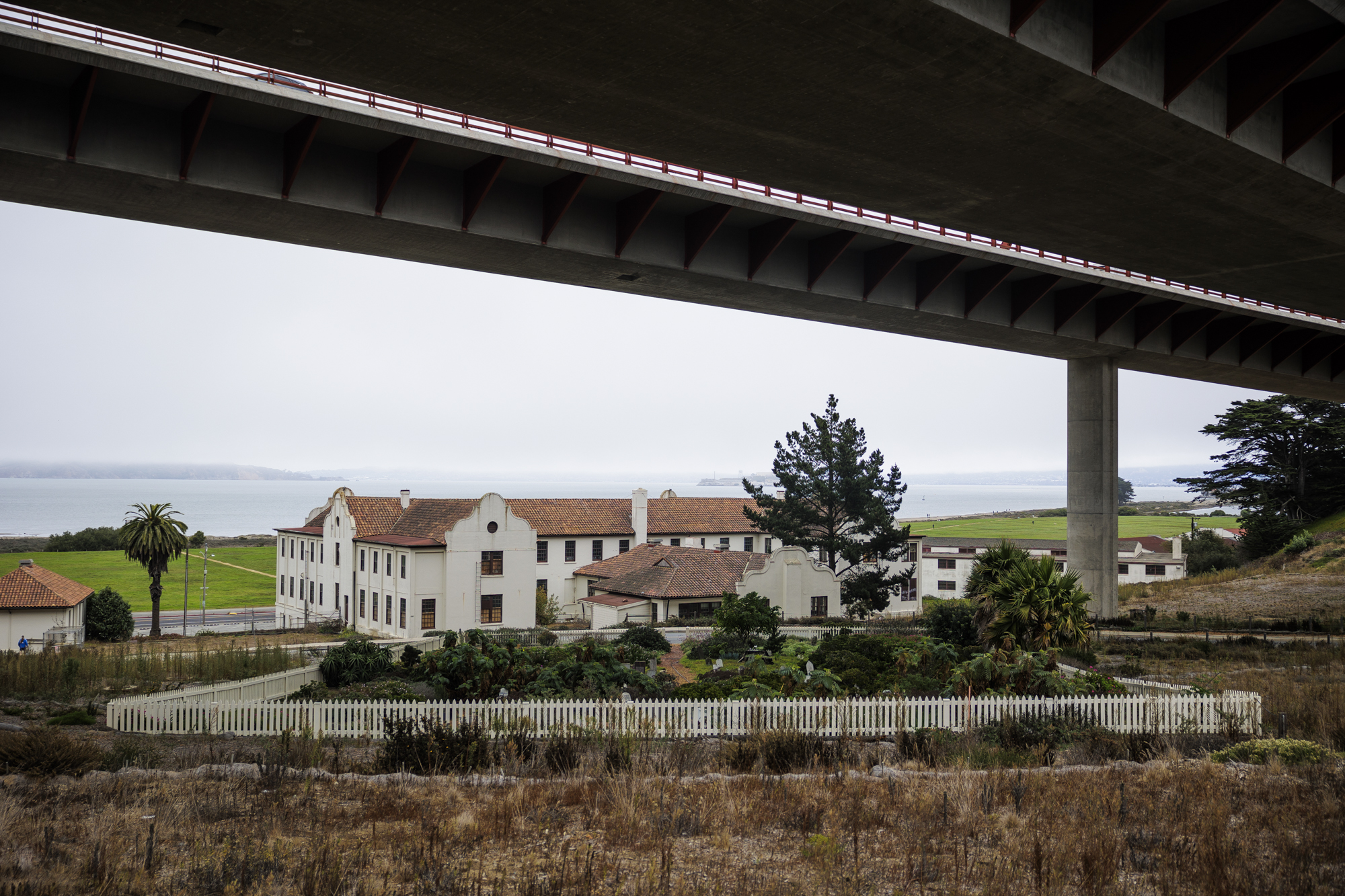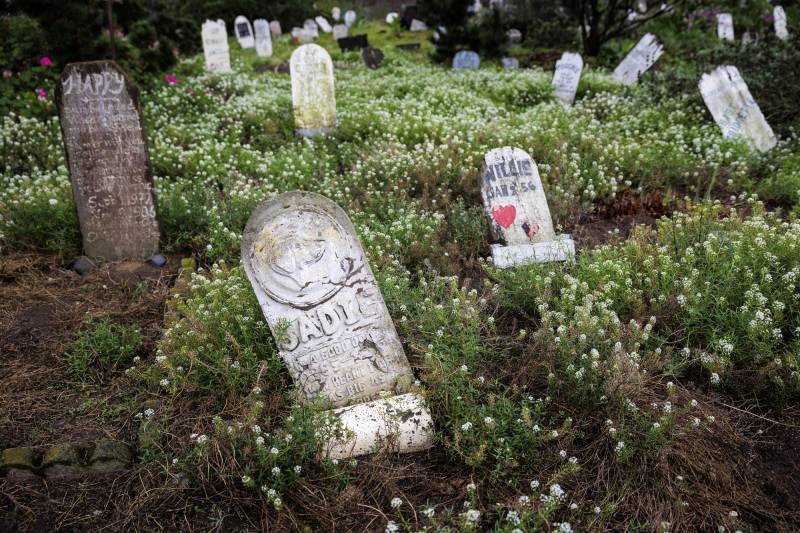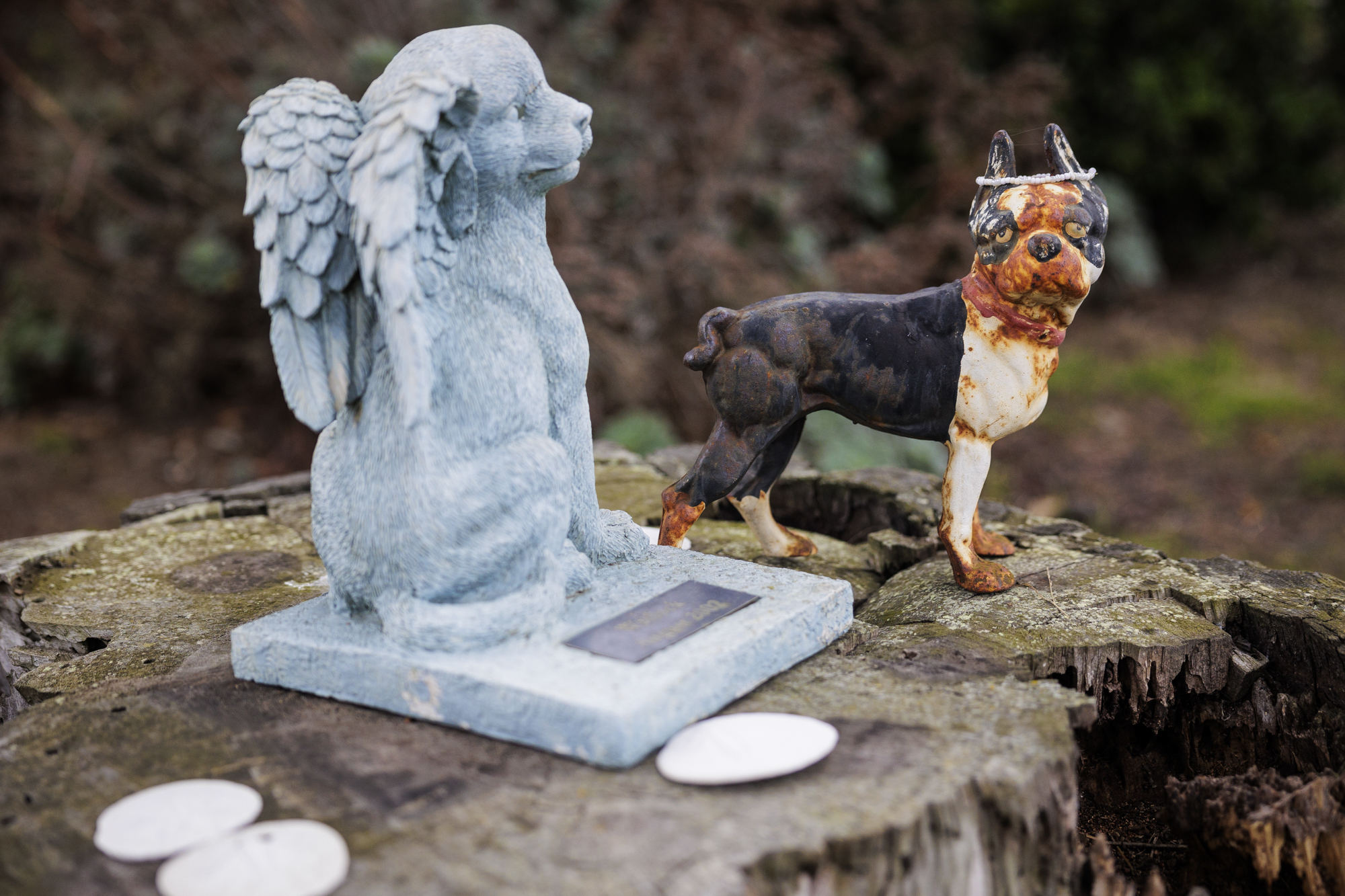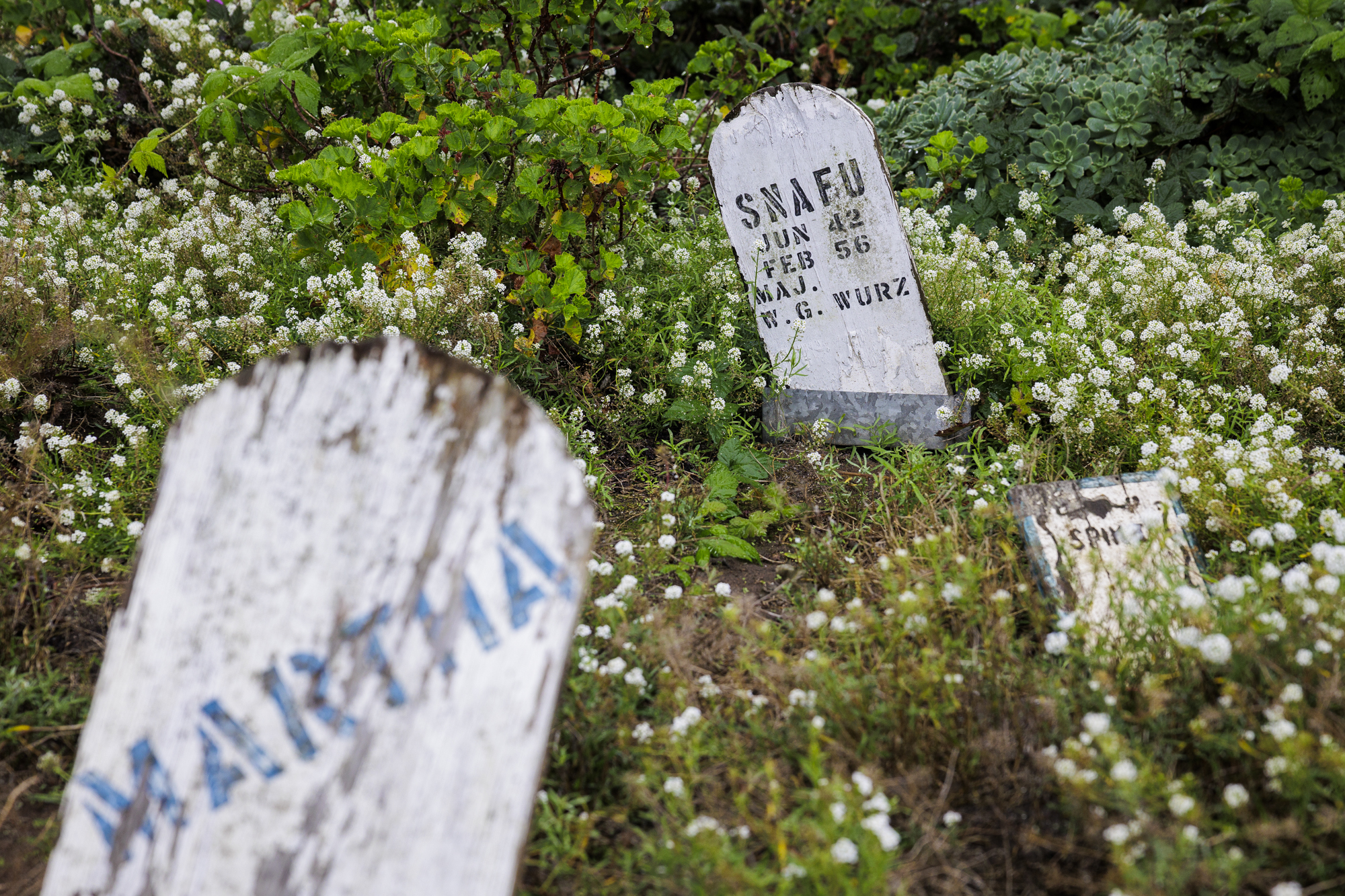Episode Transcript
Olivia Allen-Price: San Francisco has long been a tough place to be dead. In 1900, burials within San Francisco city limits were banned. And then, about a decade later, most of the deceased who had been interred were unearthed and shipped down to Colma. This was a law of the land in San Francisco, with a few exceptions.
Today’s story takes us to the Presidio to talk about a unique burial site — one that’s not for humans but for pets.
[dog bark]
Our question today comes from Willow. They are a Marin resident and parent to an adorable 8-pound schnoodle named Bluebell. Bluebell is a tiny, gray, fluffy-haired dog and a notorious fighter.
[dog growl]
Willow wanted to know…
Willow Baker: I was wondering what the story behind the pet cemetery is. I’ve always driven past it and wondered how it started, who takes care of it, and if you can still bury your pet here.
Olivia Allen-Price: I’m Olivia Allen-Price. This week on Bay Curious, we’re heading to the Presidio pet cemetery to explore this special plot of land where more than 400 pets are laid to rest. Stay with us.
SPONSOR BREAK
Olivia Allen-Price: To help answer Willow’s question about the Presidio Pet Cemetery, we sent out KQED’s Bay Curious Intern, Ana De Almeida Amaral.
Ana De Almeida Amaral: I ended up on the north side of the Presidio, on what feels like a backroad. It feels calm, except for the giant highway overpass directly above us — it’s the on-ramp to the Golden Gate Bridge. I’m here at the pet cemetery with Rob Thomson, a Federal Preservation Officer for the Presidio Trust.
Rob Thomson: So mostly dogs and cats are buried here, but you also see your occasional goldfish. There’s even an iguana. There are some birds.
Ana De Almeida Amaral: We step through a short, white picket fence into the cemetery that’s a little bit bigger than a tennis court — and as we are walking around, I realize it’s far more beautiful than I expected.
Ana De Almeida Amaral: I feel like if you drove by it, you might not even realize it’s a cemetery because it is full of, like, these pink and magenta and white flowers. It’s beautiful.
Just beyond the cemetery, there’s a picture-perfect view of the Golden Gate Bridge. Rob and I start reading the grave markers. We come across a marker that says, “Woody, one great wiener dog.” Another says, “Frodo was a good turtle.” And one that simply says, “We know love. We had this little dog.”
There are four hundred and twenty documented burials here, but the cemetery doesn’t really have the clean rows you’d imagine, it’s overgrown with big bushes of flowers, and grave markers peek out. Most of them are made of wood and painted white, though some families have placed beautiful granite and stone grave markers. Walking through the cemetery, I start to get a sense of the love that is manifested in this place.
Ana De Almeida Amaral: There’s this headstone that just says, “We loved you coco.”
The story of the Pet Cemetery starts long before it was even established.
Rob Thomson: So right now, we’re in an area of the Presidio called Cavalry Bowl. It’s an area that has a long history, over 100 years of animal management for the Army right around us right now are four cavalry stables that used to house up to 100 horses and mules. Because really, for most of the 19th and about half of the 20th century, the Army literally ran on horsepower.
Ana De Almeida Amaral: And this area is where those animals lived. You see, the Presidio of that time — the 1800s and early 1900s — was very different from the calm, picturesque national park it is today. It was an active military base filled with barracks, offices and soldiers in training. And notably, most of the men that were stationed here were single. That’s because, prior to the 20th century, many men in lower ranks of the military were not allowed to marry.
Rob Thomson: That really started to change after World War II, when the Army got bigger, but also started to bring more and more women and more and more families as the demographics of not just the Army but the country as a whole.
Ana De Almeida Amaral: Post WWII, the baby boom happened all over the country and also within the Presidio. And in a matter of years, the Presidio was no longer just the home of single men but to wives and children too. And in response, it was changing.
Rob Thomson: We have buildings like a school being built here. There’s a theater, the bowling alley that a lot of people know. Those were all, you know, created by the Army in order to serve the families that lived here.
Ana De Almeida Amaral: Once families started moving in, so did their pets. And so in 1952, Lieutenant Colonel Joseph Swing established the Presidio Pet Cemetery for service families to lay to rest their beloved pets. From the 1950s until the mid-’70s, families could pay a fee of $1 to Boy Scout Troop 70; the Boy Scouts would dig the grave and bury the pet. For the first 20 years of its existence, the pet cemetery was active and well taken care of by the Boy Scouts.
I met with Phil Gioia, who lived this new, family era of the Presidio while he was stationed here in 1975. He served on the base and would later go on to host his wedding reception at the Presidio officer’s club. He remembers how unique it was to have the pet cemetery as an official part of the base.
Phil Gioia: I mean, some posts have a kind of an informal place where they buried pets. I remember being at West Point; there was kind of an unofficial place, not at all official, but here at the Presidio, I think it was pretty much, you know, official.
Ana De Almeida Amaral: But at some point, the Boy Scouts stopped working on the cemetery. Many of the families who had buried their pets there moved — to different bases or otherwise. By the mid-’70s, the cemetery fell into disrepair, and it became a forgotten piece of land under the freeway overpass.
Phil Gioia: I used to run every day at lunchtime, and I’d pass the cemetery, which was in a pretty dilapidated state in those days. It was kind of overgrown. A lot of the little tombstones were skewed and everything kind of looked like a spooky little graveyard.
Ana De Almeida Amaral: It remained this way until a mysterious veteran was spotted repairing the cemetery. He is credited with replacing many of the rotting grave markers, caring for the landscaping, and bringing the space back from ruin. He’s mentioned in the Presidio’s newspaper in 1976, but he requested anonymity. He says that he wasn’t doing it for praise or recognition but to honor the memory of his own pup. Phil finished his military service in 1976 and left the base. But years later, he went back …
Phil Gioia: We had a cat named Fremont who was named after John C. Fremont, he was an Army officer and he was called the Explorer. And our cat was always putting his nose in the things that he didn’t really belong. So we named it Fremont after John Fremont. And he was a great cat, he really was. We got him as a really tiny little kitten. He lasted 16 years, which is really old for a cat.
Ana De Almeida Amaral: When Fremont passed, Phil called up a few of his buddies, and they went to bury him under a full moon.
Phil Gioia: So we buried him on Halloween night and my friends knew the cat, they’d known him all the years or so. And then we went to the Presidio Officers Club and had dinner and quite a bit of a bottle of bourbon. I’m sure he’s. Up there in cat heaven playing a harp with all the other cats, you know, having a good time.
Ana De Almeida Amaral: In the 90s, the Presidio transformed from a military base to a national park. The pet cemetery became part of this national park and, officially, it closed to new burials in 1994. But if you pay close attention to the dates on the gravestones, it seems like, realistically, that might not be the case. Some of the dates on grave markers show burials that occurred well into the 2000s. As one of the few places in the city where burials have been allowed in the past hundred years, it seems like San Franciscans have made good use of it. However, Rob, from the presidio trust, says that it’s really not safe to do that.
Rob Thomson: I should mention that today, burials are not allowed any longer, mainly because it’s largely full, but also because the soil out here is contaminated with lead paint from the old Doyle Drive structure that was overhead. So it’s not in anybody’s interest to be digging around in the dirt out here.
Ana De Almeida Amaral: After learning all of this about the pet cemetery, I wanted to bring our question-asker, Willow, here. So we stopped at the cemetery to look around together and read some of the grave markers.
Willow Baker: Raspberry’s says “It’s true. My basset has gone away. I know we had to part, but she’ll be with me every day with In my loving Heart from Ken.”
Willow Baker: Having a space dedicated to pets is really special. You know, they give us so much love, and we create spaces to kind of honor them. And have them live on in some way, I think… It’s nice. I don’t know.
Ana De Almeida Amaral: So, um, you can share as much or as little as you want, but a lot has kind of changed for you since you submitted that question.
Willow Baker: Unfortunately, we did have to put our family dog to sleep, BlueBell. She was 14 and just got sick all of a sudden. She was a terrible dog. She was really awful. But we loved her.
Willow Baker: She thought she was a big dog. She got into so many fights. She fought a raccoon and a deer and big dogs, and I hope that she’s terrorizing raccoons somewhere else now.
[laugh]
Ana De Almeida Amaral: Being there with Willow, I was reminded of just how painful it is to lose a furry friend who you love so much. It had been years since I remembered what that felt like — to have such a special love that crosses the boundaries of species. The pet cemetery has survived for over 70 years, through many states and transitions, brought back to life by community members, an anonymous veteran, and San Franciscans who clandestinely lay their pets to rest here.
A lot of people care about this little plot under the bridge, and I think it’s because this place exposes a really tender part of us. It reminds us just how much our pets mean to us and the lengths that we will go to love them, even after they are gone.
Olivia Allen-Price: That was KQED’s Ana De Almeida Amaral. We want to dedicate this episode to Bluebell and her beloved fighting spirit.
Thanks to Willow Baker for asking this week’s question. If you’ve got a question you’d like to hear answered on Bay Curious, head to BayCurious.org and ask! And while you’re there, be sure to sign up for the Bay Curious newsletter. It comes out once a month — so we’re not going to blow up your inbox — and features fascinating stories about our region. Again, that’s all at BayCurious.org.
This Saturday, Oct. 19th, 2024, is KQED Fest! That’s right, KQED’s free block party with live musical performances, food, art, culture and more is back by popular demand. Bay Curious will take to the stage at noon for a deep dive into a few of the propositions on your ballot this year, so swing by and say hello! Find details and register for free at KQED.org/live.




